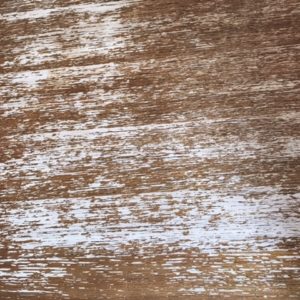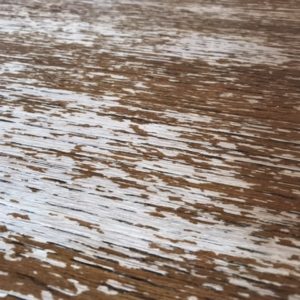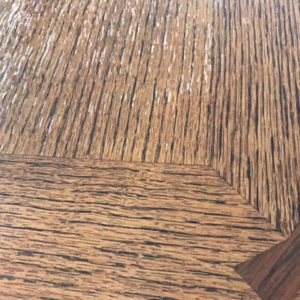This table must have had a really poor quality finish on it. I bought it new/scratch‘n’dent at slumberland 8 years ago and within several months the finish started flaking off the top where i wipe it. (I’ve always wiped it down with a lightly damp slightly soapy rag but not sopping wet…maybe that’s a no no… i grew up with a glass table so i have no idea if finished wood is supposed to handle this or not.) Fast forward 8 years and it’s a nightmare, some areas bare wood and some are still intact. It’s a very thin veneer so i am hesitant to sand much…i am also concerned about dissolving the veneer’s glue with acetone. I tried a spot of acetone, and after using acetone i was able to chip the finish off with my fingernail. I dont need this table to be perfect but i’d like to refinish the surface well enough that it’s no longer an eyesore and i’d like the surface to be protected from water and stains soaking into the wood. I want to do it without too much manual scraping too as i have a bad neck. It needs to get me by a few more years until i can afford to replace it with a SOLID wood table. Ideas? I’m considering using a small mouse sander, just enough to scuff it up (so another coat of poly will adhere) but not completely remove the existing finish, get a matching stain to color the areas that are already completely bare wood, then go over it all with an oil based polyurethane or something. Would this work? Should i use poly or something different? Thoughts?
Discussion Forum
Get It All!
UNLIMITED Membership is like taking a master class in woodworking for less than $10 a month.
Start Your Free TrialDiscussion Forum
Digital Plans Library
Member exclusive! – Plans for everyone – from beginners to experts – right at your fingertips.
Highlights
-
Shape Your Skills
when you sign up for our emails
This site is protected by reCAPTCHA and the Google Privacy Policy and Terms of Service apply. -
 Shop Talk Live Podcast
Shop Talk Live Podcast -
 Our favorite articles and videos
Our favorite articles and videos -
E-Learning Courses from Fine Woodworking
-
-
 Fine Woodworking New England Event
Fine Woodworking New England Event















Replies
Looks like water damage and grain separation to me.
2 coats of tung oil, let it cure for a month, then sand and topcoat with poly. OR, with all due respect, it probably doesn't owe you anything by now... drive it into the ground as is, or burn it. I would not blame the original finish for anything considering how it has been cared for. Perfect window to build yourself a new table.
I think that the process that will have the least chance of damaging the veneer and least physical effort is to get the best stripper you can get and use that. Follow the directions on the container as closely as you can. This will probably require some scraping with a plastic scraper to remove the desolved finish but, it is not physically demanding. When all of the existing finish is removed, you will likely need to do a light sanding because the grain will be raised and feel somewhat rough. If the veneer still looks good after this process is completed, you can decide if you want to put on a clear finish or paint it. If the veneer gets damaged, you probably will have little choice but to paint it and this is OK. A good paint job will give you several years of service.
Once the stripping is done, you can decide if you want a clear finish or paint. If you decide on a clear finish, you have the choice between water based and oil based and either is OK. I would only suggest that if you use a stain first stay with the same base, water or oil.
I second the use of paint stripper, it should easily remove the already defective finish and leave the wood bare after cleaning with mineral spirit. A light hand sanding with a block and 150-180 grit sandpaper, vacuum clean and apply a clear poly per the instructions on the can. This actually looks like a nice riftsawn oak tabletop.
thanks everyone for the help! for the future... how SHOULD one clean a wood table? sticky with maple syrup for example....? thanks!
A table top with a good varnish or polyurethane finish should be able to withstand repeated washing with a cloth dampened with a mild soapy water solution. It should not be flooded and left wet. An occasional coat of paste wax will make cleaning easier. Harsh liquid or powdered cleansers should be avoided. Also, avoid scouring pads.
This forum post is now archived. Commenting has been disabled